Bump drafting? 500 what? A non-NASCAR-fan's guide to the Daytona 500
"Drivers, start your engines!" That's what Tiffany Haddish will be yelling to a long line of racecars Sunday afternoon. The green flag will drop, the engines will roar, over a hundred thousand people will start screaming, and the 65th annual Daytona 500 will begin.
But if you're not a race fan, you may not understand why all your race-fan buddies are wearing hats with numbers on them this weekend or why Publix is out of beer.
If you just want to know what's going on, read on.
Picking a winner: Kurt is out, Jimmie is back, and, wait, who has the best career Daytona top-10 percentage?
Daytona 500 odds: From Denny Hamlin and Ryan Blaney to Travis Pastrana, pick a winner
What is the Daytona 500?
The Daytona 500 is the stock car race that kicks off the new NASCAR Cup Series every year. It's huge, it's important, and yes, it's a little weird for a sport to have its most important event at the beginning of the season but, as you'll hear fans say a lot, "That's racin'."
Racers covet a Daytona 500 win. It has the biggest purse of any NASCAR race but more than that, it's the prestige. It's the Super Bowl ring, the Masters jacket, the Olympic medal. Celebrities, politicians, even presidents show up to watch the race. In 2022, over 8.9 million people watched the 500 and from 1995 to 2020, television ratings in the U.S. for the Daytona 500 were higher than any other auto race.
It's also a full-day event. Fox Sports will be full of analysis and predictions and driver interviews, and at the track there are fan activities and a prerace concert by country music star Dierks Bentley.
The Daytona 500 began in 1959 when NASCAR founder Bill France wanted to get Daytona's stock car races off the beach where they'd been tearing up the sand for five decades and into a track with high banks so the cars could go faster (and where fans might be more likely to buy stuff). He and some backers built the Daytona International Speedway and the 500 was born.
'If you win, you become a legend': Speedweek signals green flag for NASCAR's 75th season
Daytona 500 means unpredictability: What to know as drivers get set for NASCAR's greatest race
Hell-on-wheels huge:Daytona 500, by NASCAR design, has become the "Greatest" American Race
When and where is the Daytona 500?
The Daytona 500 is held on a Sunday in February at the Daytona International Speedway in Daytona Beach, Florida. The 2023 Daytona 500 will begin Sunday, Feb. 19 at 2:30 p.m. EST.
GREEN FLAG! Speedweek is here and leads to Sunday's Daytona 500. Here's the full schedule
More:Richard Petty, Jeff Gordon, Bobby Allison among nine grand marshals for Daytona 500
How can I watch the Daytona 500 and what TV channel is it on? Is the Daytona 500 streaming?
If you were hoping to watch it in person, too late. It's sold out for the eighth-straight year. But you can still watch it.
The Daytona 500 will be broadcast on Fox or Fox Sports 1. It also will be streamed on Fox Sports Live and the Fox Sports app.
If you don't have cable, you can get Fox with memberships to Hulu + Live, FuboTV, Sling TV, YouTubeTV and DirecTV Stream.
If you just want to listen, you can follow along on the Motor Racing Network (MRN) or on SiriusXM NASCAR Ch. 50.
How to watch NASCAR in 2023: Dates, times and TV networks for all Cup Series races
Prerace show:Daytona 500 prerace concert to feature country music star Dierks Bentley
More:Daytona 500 green flag starter is Tiffany Haddish; WWE's Charlotte Flair honorary race official
What does the 500 mean in the Daytona 500? How many laps are there?
To win the Daytona 500, a driver must be the first one to finish 200 laps around the 2.5 mile track. That makes it 500 miles. See? Easy.
How long does the Daytona 500 last?
Usually between three and four hours if all goes well and there are no major multi-car wrecks or adverse track conditions and it doesn't rain.
What happens if the Daytona 500 gets rained out?
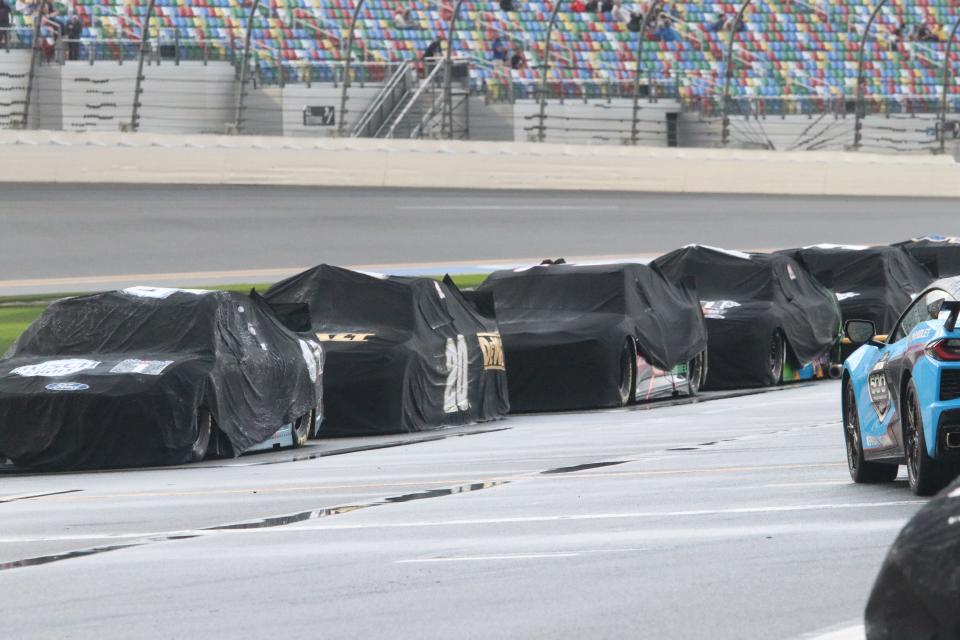
It stops. For a while.
The cars pull to the side and get covered. Teams aren't allowed to work on them. Fans huddle under ponchos. Drivers often get on social media and post selfies. Basically, the whole event hunkers down and waits for the rain to pass, and then the fleet of Air Titans hit the track to dry it out. The Air Titans are vacuum/sweeper trucks equipped with compressed air to blow water off the track and suck it up.
Drivers have even left the Speedway during long delays to get some fast food.
The Daytona 500 runs in three stages where drivers in the lead can earn points. The first two stages are 65 laps each and the final one is 70. If worst comes to worst and the race has to stop, the driver in the lead after at least 100 laps or the end of Stage 2, whichever comes first, will be declared the winner.
As it's the jewel of NASCAR's crown, officials will try their hardest to run the complete race and in some years they have been delayed and restarted well into the night and the next morning to get a winner, or postponed to Monday.
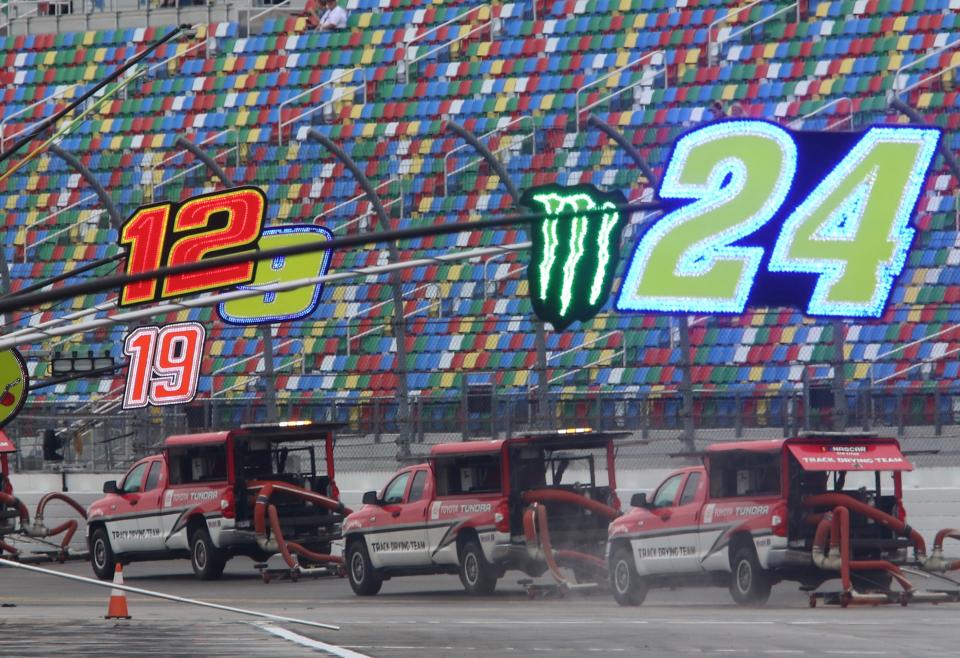
Drying the track:Eventually, when the rain stops at the Daytona 500, NASCAR's Air Titans will roll out and save the day
Rain delay refueling:Chase Briscoe, Ross Chastain drive to Panda Express, McDonald's during Daytona 500 rain delay
How many cars start in the Daytona 500?
There are 40 drivers in the 2023 Daytona 500.
Drivers compete in two qualifying races in the week leading up to the big race to see who gets in. The winners of each qualifying race become the first two cars in the starting lineup of the Daytona 500. (This year, that's Alex Bowman and Kyle Larson.) The third and fourth spots are held by the winners of two more races after that called the Duels, currently known as the Bluegreen Vacations Duel races. Races can change sponsors from year to year so the same annual race may have different names.
NASCAR DUELS: Logano, Almirola win but Smith, Daly also winners; Daytona 500 starting lineup
Ken Willis:List of NASCAR's top 75 Cup Series drivers hard to get right ... or wrong
Start your engine: 10 tips on how to become a NASCAR driver
How fast do cars go in the Daytona 500? What's the maximum speed?
The fastest recorded time in NASCAR history was 212.089 mph by Bill Elliott during a qualifying run at Talladega Superspeedway. And it will remain the fastest recorded time because after some truly spectacular wrecks and a fatality NASCAR started mandating restrictor plates on all cars in 1987 and have made other changes since to slow everyone down.
Top speeds in the qualifying races this week were just over 181 mph, and at their fastest in the drafts (see below) the drivers in the Daytona 500 will probably be hitting in the 190s.
KEN WILLIS: Yes, NASCAR has slowed its roll at Daytona, but chaos is unlikely to abide
Why are the Thunderbirds at the Daytona 500?
The U.S. Air Force Thunderbirds will perform their signature “Delta” formation over the Speedway at the end of the National Anthem for the start of the Daytona 500 as they have since 2010.
“We are excited to fly over the Daytona 500 again this year,” Lt. Col. John Caldwell, commander and leader of the Thunderbirds, said in 2021. “This amazing event has kicked off our demonstration season for the past 10 years, and we are grateful for the partnership between the Speedway and Air Force."
What's bump drafting? What's a pace car? When does a caution flag fly?
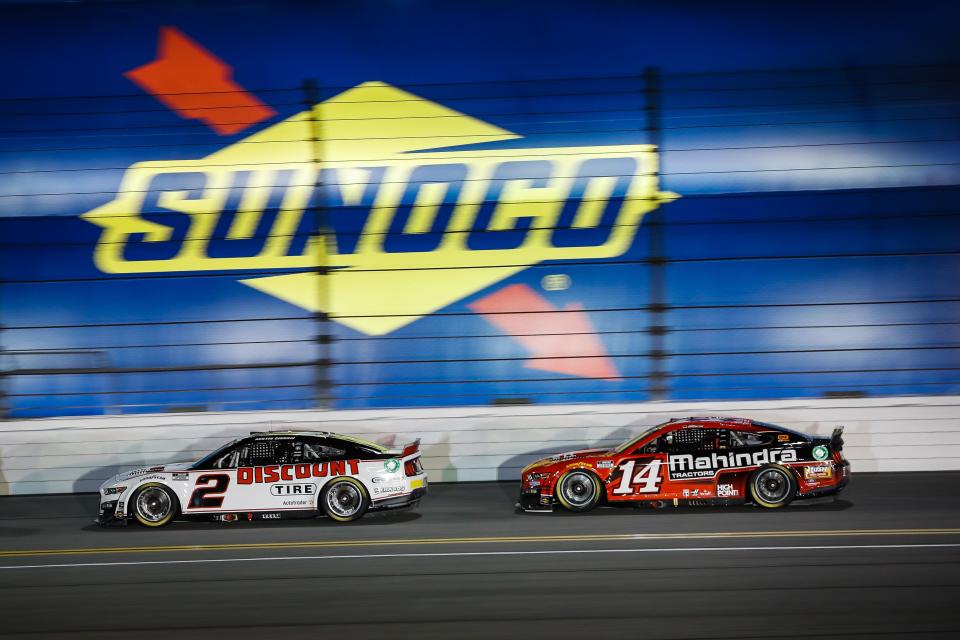
A quick guide to some basic racing terminology:
The field: All the cars on the track.
Pace car: A car that comes out and leads the field around the track during caution stops and restarts. Like being stuck behind a student driver.
Green flag: When this is waved, the race begins.
Caution flag: This yellow flag is waved when there's a hazardous situation on track. The pace car comes out and keeps a steady 70 mph speed to slow the field down while the problem is resolved.
Green-white-checker flag: This gets waved when the race only has two more laps but there's a caution flag. It means the race will be extended two more laps.
Checkered flag: Waved when the winner crosses the start/finish line.
Drafting: This is physics stuff. When you see two cars driving one after the other, almost touching, they're drafting. The first car is punching a hole in the air, creating a bubble or vacuum behind it. A second car, slipping into that bubble, gets much less air resistance and can go faster. What's wild is if that happens, the formation of the two even gives the driver in front a little boost so two cars driving closely together can go faster than one car alone.
Restrictor plate: Something that limits a car's speed, mandated by NASCAR after escalating speeds and drafting led to some spectacular wrecks and a fatality.
Bump drafting: Drafting, weaponized. If you're trying to pass someone you can slip into that air bubble behind their car, speed up and then "bump" or push the car in front. That raises the rear of their car a bit, and when it comes back down the car can lose traction and the driver may have to correct, allowing you a chance to get around them. Bump drafting was banned from NASCAR in 2014.
What does the winner win in the Daytona 500?
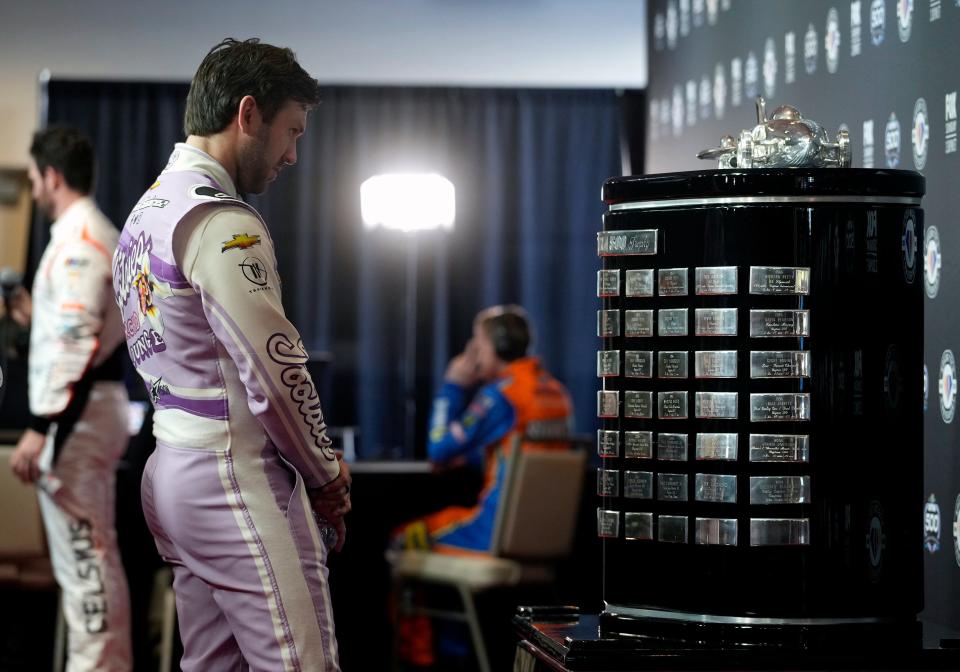
Lifetime bragging rights, a bunch of money, and their name on a really big trophy.
The total purse — all the money available to win — for the 2023 Daytona 500 is $26,934,357, probably for some very good bookkeeping reason. But how much will the winner get? No idea.
NASCAR stopped releasing prize money figures in 2016 so we don't know the actual breakdown. In 2015, it worked out to about 9% of the total so if that holds true, the winner of the 2023 Daytona 500 should get a payday of about $2.4 million.
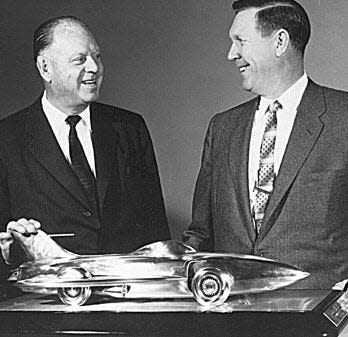
When they get to Victory Lane and get hosed down with celebratory champagne or whatever beverage they're sponsoring, the winner of the Daytona 500 also will be presented with the Harley J. Earl Trophy, a four-foot-tall, five-foot-wide black and silver creation adorned with the winners of every Daytona 500. It's named after, yes, Harley J. Earl, an automobile designer, the father of the Corvette and the second commissioner of NASCAR.
Who is Harley J. Earl?And why is the Daytona 500 champion's trophy named after him?
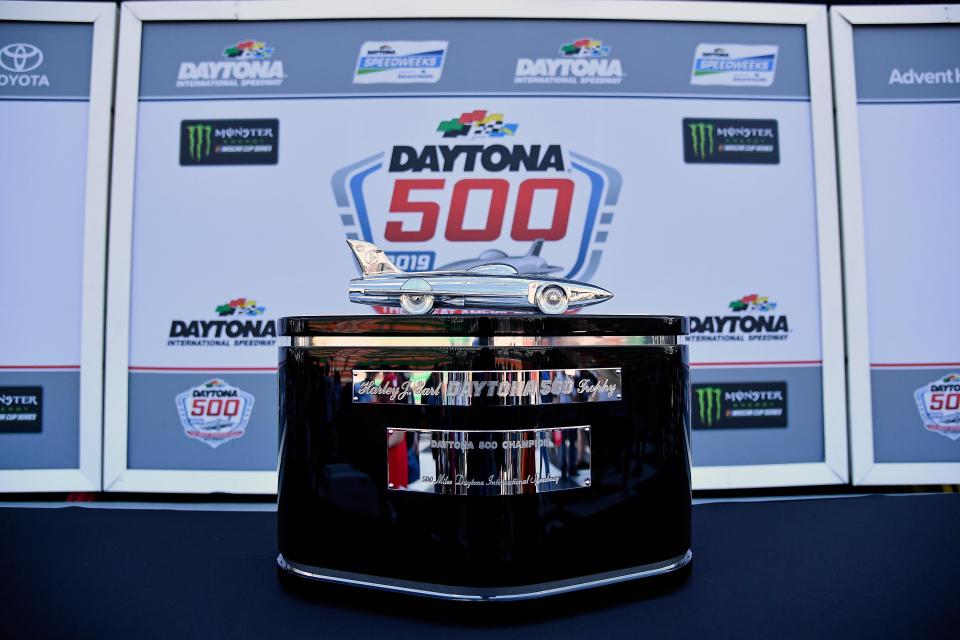
They don't get to keep it, though. After the presentation, the trophy, also known as the Harley J. Earl Perpetual Trophy, gets put back on display at Daytona International Speedway and the winner gets a smaller replica with a black base and a scaled-down replica of the Firebird One that Earl created in 1954.
The winner's car also is put on display next to the trophy for the next year.
C. A. Bridges is a Digital Producer for the USA TODAY Network, working with multiple newsrooms across Florida. Local journalists work hard to keep you informed about the things you care about, and you can support them by subscribing to your local news organization. Read more articles by Chris here and follow him on Twitter at @cabridges
This article originally appeared on The Daytona Beach News-Journal: Daytona 500: The non-racing fan's guide to the Great American race

